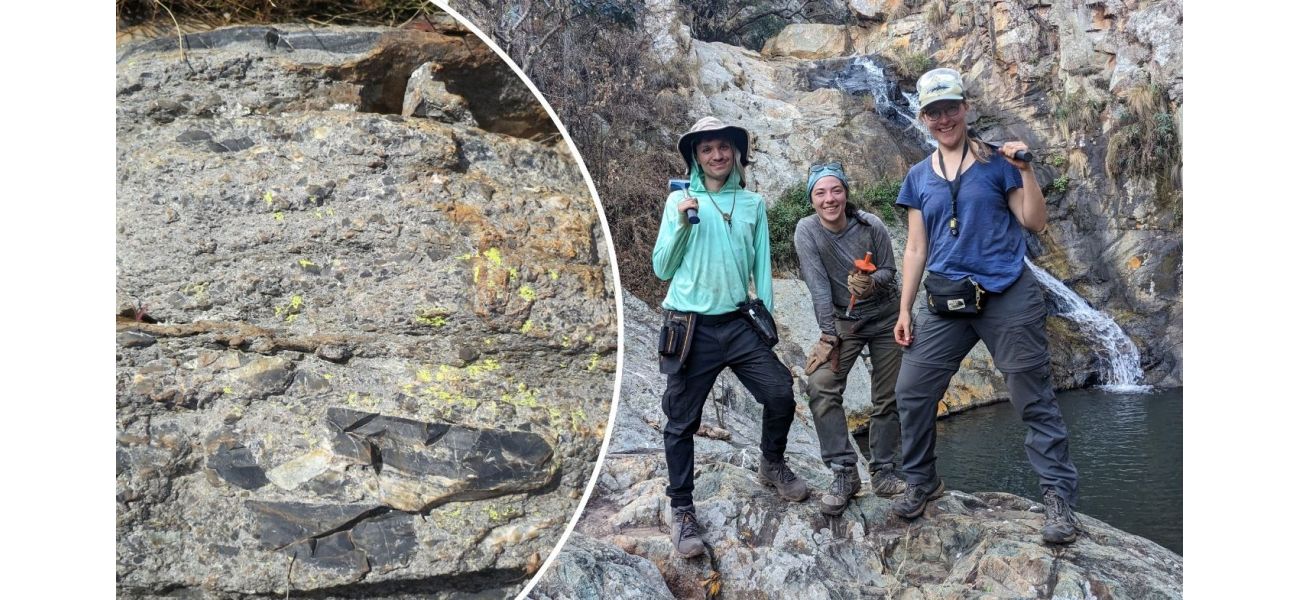A massive rock caused the ocean to boil 3.2 billion years ago, acting as a catalyst for life to flourish.
New study reveals possible answer to our existence.
October 22nd 2024.

Billions of years ago, Earth was a very different place. It was a young planet, still in its early stages of formation. And just like any other planet, it wasn't immune to collisions with space rocks. One such collision occurred more than 3 billion years ago when a massive meteorite, estimated to be four times the size of Mount Everest, struck the planet. This event may seem catastrophic, but new research suggests that it may have actually been beneficial for the earliest forms of life on Earth.
When a large space rock crashes into a planet, it usually results in catastrophic devastation. We've seen this in the case of the dinosaurs, when a 10-kilometre-wide asteroid crashed into Earth and caused their extinction 66 million years ago. However, Earth was still in its early stages when the S2 meteorite hit. According to Nadja Drabon, an assistant professor at Harvard University, the S2 meteorite had 50 to 200 times more mass than the asteroid that wiped out the dinosaurs. Despite its size, the impact may have actually been beneficial for the planet.
At the time of the S2 impact, Earth was a water world with few islands. The oceans were filled with single-celled life, but not as much as we see today due to a lack of nutrients. Some even describe this period as a "biological desert" because of the limited amount of life present. The oceans were a curious sight, being green in color from iron-rich deep waters. But when the S2 meteorite hit, it caused global chaos. However, it also stirred up ingredients that may have enriched bacterial life.
Uncovering the effects of ancient impacts is no easy task. During Earth's early history, space rocks frequently hit the planet, with one giant impact occurring every 15 million years. This means that at least 16 giant meteorites hit Earth during the Archean Eon, which lasted from 4 billion to 2.5 billion years ago. However, the evidence of these impacts is hard to find due to Earth's ever-changing geology.
Drabon and her team conducted fieldwork in the Barberton Makhonjwa Mountains of South Africa to search for clues. In this area, they found geological evidence of eight impact events that occurred between 3.6 billion and 3.2 billion years ago. They were able to trace these events through tiny meteorite impact particles called spherules. These small, round particles form sedimentary layers in rocks and provide evidence of impact events.
The team collected samples from various locations and analyzed their compositions and geochemistry. This allowed them to reconstruct what happened when the S2 meteorite hit. They found that the tightly sandwiched layers of rock preserved a mineral timeline that gave insight into the effects of the impact. Their research may change the way we understand how Earth and its early life forms responded to bombardment from space rocks.
Human-like Text:
Billions of years ago, a colossal space rock, estimated to be equivalent to four Mount Everests, collided with Earth. This event, according to new research, may have surprisingly benefitted the earliest forms of life on our planet. Typically, when a massive space rock strikes Earth, it results in catastrophic destruction, like the extinction of the dinosaurs 66 million years ago when a 10-kilometer-wide asteroid hit the Yucatan Peninsula in Mexico.
However, the S2 meteorite that crashed into Earth 3.26 billion years ago was a different story. It weighed 50 to 200 times more than the asteroid that caused the dinosaur extinction, yet it may have had a positive impact on our planet. Nadja Drabon, an assistant professor of Earth and planetary sciences at Harvard University, explains that Earth was a very different place back then. It was young, and complex life had not yet formed. The only life present was single-celled bacteria and archaea. The oceans contained some life, but not as much as we see today due to a lack of nutrients. Some scientists even describe the oceans during this time as "biological deserts." The Earth was mostly covered in water, with few islands peeking out. The oceans were probably green from the iron-rich deep waters, creating a curious sight.
The collision of the S2 meteorite caused chaos globally. However, it also stirred up ingredients that may have enriched bacterial life. These new findings could change our understanding of how Earth and its early lifeforms responded to bombardment from space rocks soon after the planet's formation.
During the early years of Earth, it was frequently hit by space rocks. The study authors estimate that giant impactors, greater than 10 kilometers wide, struck the planet every 15 million years. This means that at least 16 giant meteorites collided with Earth during the Archean Eon, which lasted from 4 billion to 2.5 billion years ago. However, there is limited knowledge about the aftermath of these impact events. With Earth's ever-changing geology, it is challenging to find evidence of events that occurred millions of years ago due to volcanic activity and tectonic plate movement.
Drabon, a geologist focused on early Earth, is determined to understand what the planet was like before the first continents formed and how meteorite impacts affected life's evolution. She explains, "These impacts must have significantly influenced the origin and evolution of life on Earth. But, the exact impact remains a mystery." Her research aimed to examine tangible evidence of how giant impacts affected early life.
Drabon and her team conducted fieldwork in the Barberton Makhonjwa Mountains of South Africa, searching for clues in the rocks. Geological evidence of eight impact events that occurred between 3.6 billion and 3.2 billion years ago can be found in the rocks, traced through tiny meteorite impact particles called spherules. These small, round particles, which can be glassy or crystalline, form when large meteorites strike Earth and create sedimentary layers in rocks known as spherule beds.
The team collected various samples in South Africa and analyzed their compositions and geochemistry. Drabon explains, "Our days usually begin with a long hike into the mountains to reach our sampling locations. Sometimes, we are fortunate to have dirt roads that bring us closer. At the site, we study the structures in the rocks across the impact event layer in great detail and use sledgehammers to extract samples for later lab analysis."
Through the layers of rock, the team was able to reconstruct a timeline of events that occurred when the S2 meteorite hit. These findings shed light on the impact of meteorites on early Earth and how they may have influenced the evolution of life.
When a large space rock crashes into a planet, it usually results in catastrophic devastation. We've seen this in the case of the dinosaurs, when a 10-kilometre-wide asteroid crashed into Earth and caused their extinction 66 million years ago. However, Earth was still in its early stages when the S2 meteorite hit. According to Nadja Drabon, an assistant professor at Harvard University, the S2 meteorite had 50 to 200 times more mass than the asteroid that wiped out the dinosaurs. Despite its size, the impact may have actually been beneficial for the planet.
At the time of the S2 impact, Earth was a water world with few islands. The oceans were filled with single-celled life, but not as much as we see today due to a lack of nutrients. Some even describe this period as a "biological desert" because of the limited amount of life present. The oceans were a curious sight, being green in color from iron-rich deep waters. But when the S2 meteorite hit, it caused global chaos. However, it also stirred up ingredients that may have enriched bacterial life.
Uncovering the effects of ancient impacts is no easy task. During Earth's early history, space rocks frequently hit the planet, with one giant impact occurring every 15 million years. This means that at least 16 giant meteorites hit Earth during the Archean Eon, which lasted from 4 billion to 2.5 billion years ago. However, the evidence of these impacts is hard to find due to Earth's ever-changing geology.
Drabon and her team conducted fieldwork in the Barberton Makhonjwa Mountains of South Africa to search for clues. In this area, they found geological evidence of eight impact events that occurred between 3.6 billion and 3.2 billion years ago. They were able to trace these events through tiny meteorite impact particles called spherules. These small, round particles form sedimentary layers in rocks and provide evidence of impact events.
The team collected samples from various locations and analyzed their compositions and geochemistry. This allowed them to reconstruct what happened when the S2 meteorite hit. They found that the tightly sandwiched layers of rock preserved a mineral timeline that gave insight into the effects of the impact. Their research may change the way we understand how Earth and its early life forms responded to bombardment from space rocks.
Human-like Text:
Billions of years ago, a colossal space rock, estimated to be equivalent to four Mount Everests, collided with Earth. This event, according to new research, may have surprisingly benefitted the earliest forms of life on our planet. Typically, when a massive space rock strikes Earth, it results in catastrophic destruction, like the extinction of the dinosaurs 66 million years ago when a 10-kilometer-wide asteroid hit the Yucatan Peninsula in Mexico.
However, the S2 meteorite that crashed into Earth 3.26 billion years ago was a different story. It weighed 50 to 200 times more than the asteroid that caused the dinosaur extinction, yet it may have had a positive impact on our planet. Nadja Drabon, an assistant professor of Earth and planetary sciences at Harvard University, explains that Earth was a very different place back then. It was young, and complex life had not yet formed. The only life present was single-celled bacteria and archaea. The oceans contained some life, but not as much as we see today due to a lack of nutrients. Some scientists even describe the oceans during this time as "biological deserts." The Earth was mostly covered in water, with few islands peeking out. The oceans were probably green from the iron-rich deep waters, creating a curious sight.
The collision of the S2 meteorite caused chaos globally. However, it also stirred up ingredients that may have enriched bacterial life. These new findings could change our understanding of how Earth and its early lifeforms responded to bombardment from space rocks soon after the planet's formation.
During the early years of Earth, it was frequently hit by space rocks. The study authors estimate that giant impactors, greater than 10 kilometers wide, struck the planet every 15 million years. This means that at least 16 giant meteorites collided with Earth during the Archean Eon, which lasted from 4 billion to 2.5 billion years ago. However, there is limited knowledge about the aftermath of these impact events. With Earth's ever-changing geology, it is challenging to find evidence of events that occurred millions of years ago due to volcanic activity and tectonic plate movement.
Drabon, a geologist focused on early Earth, is determined to understand what the planet was like before the first continents formed and how meteorite impacts affected life's evolution. She explains, "These impacts must have significantly influenced the origin and evolution of life on Earth. But, the exact impact remains a mystery." Her research aimed to examine tangible evidence of how giant impacts affected early life.
Drabon and her team conducted fieldwork in the Barberton Makhonjwa Mountains of South Africa, searching for clues in the rocks. Geological evidence of eight impact events that occurred between 3.6 billion and 3.2 billion years ago can be found in the rocks, traced through tiny meteorite impact particles called spherules. These small, round particles, which can be glassy or crystalline, form when large meteorites strike Earth and create sedimentary layers in rocks known as spherule beds.
The team collected various samples in South Africa and analyzed their compositions and geochemistry. Drabon explains, "Our days usually begin with a long hike into the mountains to reach our sampling locations. Sometimes, we are fortunate to have dirt roads that bring us closer. At the site, we study the structures in the rocks across the impact event layer in great detail and use sledgehammers to extract samples for later lab analysis."
Through the layers of rock, the team was able to reconstruct a timeline of events that occurred when the S2 meteorite hit. These findings shed light on the impact of meteorites on early Earth and how they may have influenced the evolution of life.
[This article has been trending online recently and has been generated with AI. Your feed is customized.]
[Generative AI is experimental.]
0
0
Submit Comment





